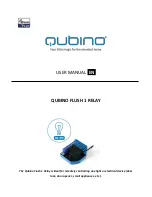
4.13
Date Code 20170814
Instruction Manual
SEL-700G Relay
Protection and Logic Functions
Group Settings (SET Command)
the MVA setting (that is, MVA is not set to OFF), the relay uses the MVA,
winding voltage, CT ratio, and CT connection settings (see Table 4.2) you
have entered and calculates the TAPX and TAPT values automatically. You
can also directly enter tap values when MVA := OFF. The ratio of maximum
(TAPn/INOMn) to the minimum (TAPn/INOMn) must be less than or equal to
7.5, where INOMn (n = X, Y) is the nominal rating of the CT, 5 A or 1 A.
The ICOM setting defines whether the input currents need any correction,
either to accommodate phase shifts in the transformer or CTs, or to remove
zero-sequence components from the secondary currents. If this setting is Y,
the relay permits you, in the next group of settings, to define the amount of
shift necessary to align the secondary currents properly for the differential
calculation.
Settings CTCX and CTCY for Winding X and Y, respectively, define the
amount of compensation to each set of the winding currents. The relay
automatically sets CTCX to 0 when ICOM := N. These settings account for
phase shifts in transformer winding connections and also in CT connections.
For example, this correction is necessary if all the CTs are connected in wye in
a delta-wye step-up transformer application. The effect of the compensation is
to create phase shift and removal of zero-sequence current components.
Set the operating current level O87P at a minimum for increased sensitivity
(0.2 to 0.3 for transformers and around 1.0 for buses), but high enough to
avoid operation because of unmonitored loads and transformer excitation
current. O87P must be greater than or equal to the minimum of 0.1 • INOMn/
TAPn, where n = X, Y.
The SEL-700G1 includes a differential current alarm feature. Set the 87AP
level above the highest expected differential current under normal operations
(typically lower than O87P) setting) and a security delay 87AD. See
Figure 4.8 for the logic diagram of this feature. Assertion of Relay Word bit
87AT indicates a problem in the differential current circuit (e.g., open CT).
You must program the 87AT bit to take appropriate action (alarm, display
message, SER, etc.) as desired.
Figure 4.8
Differential Current Alarm Logic Diagram
Use the restraint slope percentage settings to discriminate between internal
and external faults. Set SLP1 to accommodate current differences from
steady-state and proportional errors such as power transformer tap-changer,
CT errors, and relay error. Set SLP2 to accommodate transient error caused by
CT saturation.
A two-slope, or variable-percentage differential application, improves
sensitivity in the region where CT error is less and increases security in the
high-current region where CT error is greater. We must define both slopes, as
well as the Slope 1 limit or point IRS1, where SLP1 and SLP2 intersect. If you
want a single slope characteristic, set both SLOPE1 and SLOPE2 to the
desired slope value.
The purpose of the instantaneous unrestrained current element is to react
quickly to very heavy current levels that clearly indicate an internal fault. Set
the pickup level U87P to 8 to 10 times tap. The unrestrained differential
87AP
(setting)
87AD
0
IOP1
_
+
87AT
87AP
AP2
AP3
AP1
Relay
Word
Bits
Summary of Contents for SEL-700G Series
Page 14: ...This page intentionally left blank ...
Page 22: ...This page intentionally left blank ...
Page 32: ...This page intentionally left blank ...
Page 52: ...This page intentionally left blank ...
Page 106: ...This page intentionally left blank ...
Page 510: ...This page intentionally left blank ...
Page 560: ...This page intentionally left blank ...
Page 578: ...This page intentionally left blank ...
Page 588: ...This page intentionally left blank ...
Page 604: ...This page intentionally left blank ...
Page 634: ...This page intentionally left blank ...
Page 738: ...This page intentionally left blank ...
Page 802: ...This page intentionally left blank ...
















































